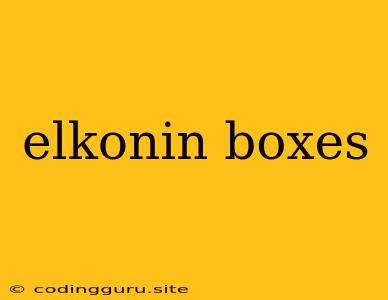Unlocking the Power of Elkonin Boxes: A Guide for Literacy Success
Have you ever wondered how children learn to decode words and sound out those tricky letters? The answer may lie in a simple yet powerful tool: Elkonin boxes. Developed by Russian psychologist D. B. Elkonin, these boxes are a visual and interactive method that helps children break down words into their individual sounds, a critical step in developing phonological awareness.
What are Elkonin Boxes?
Elkonin boxes, also known as sound boxes, are a set of squares or boxes, typically three to six, drawn on a sheet of paper or whiteboard. Each box represents a sound or phoneme in a word. Children use these boxes to segment (break apart) words into individual sounds and then blend those sounds back together to form the word.
How do Elkonin Boxes Work?
Elkonin boxes work by providing a visual representation of the sound structure of words. The process is simple:
- Choose a word: Select a word that you want your child to learn or practice.
- Draw the boxes: Draw the number of boxes that corresponds to the number of sounds in the word. For example, the word "cat" would need three boxes, one for each sound /k/, /æ/, and /t/.
- Sound out the word: Say the word slowly and distinctly, pausing after each sound.
- Place markers: As you say each sound, place a marker (such as a counter, a block, or a small object) in the corresponding box.
- Blend the sounds: Once all the sounds are represented, guide the child to blend the sounds together to form the word.
Benefits of Using Elkonin Boxes
Elkonin boxes offer a range of benefits for children learning to read and spell:
- Improved Phonological Awareness: By segmenting and blending sounds, children develop a deeper understanding of how words are made up of individual sounds.
- Enhanced Sound-Symbol Correspondence: Elkonin boxes help children connect sounds with their corresponding letters, strengthening their phonics skills.
- Visual Support: The visual nature of Elkonin boxes provides a clear and concrete representation of the word's structure, making it easier for children to grasp the concept of phonemic awareness.
- Increased Engagement: The interactive nature of Elkonin boxes, using markers or objects, makes learning fun and engaging for children.
- Individualized Learning: Elkonin boxes can be adapted to meet the specific needs of each child. For example, you can start with simple words and gradually increase the complexity as the child progresses.
Using Elkonin Boxes in Practice
Here are some practical tips for incorporating Elkonin boxes into your teaching or home learning activities:
- Start with simple words: Begin with short, one-syllable words with clear sounds, such as "cat," "dog," "sun," and "hat."
- Use a variety of markers: Experiment with different markers like counters, blocks, or small toys to keep things interesting for children.
- Make it a game: Turn Elkonin boxes into a fun activity by making it a race to see who can place the markers fastest or create a simple reward system.
- Encourage repetition: Repeat the process of segmenting and blending sounds multiple times for each word.
- Connect to real-life: Use Elkonin boxes to sound out words related to everyday objects, activities, or stories.
Examples of Using Elkonin Boxes
Let's look at some examples of how Elkonin boxes can be used to teach different aspects of reading and spelling:
- Decoding a word: To decode the word "train," draw four boxes and say the sounds /t/, /r/, /e/, and /n/, placing a marker in each box as you go. Then blend the sounds together to pronounce the word.
- Spelling a word: To spell the word "jump," draw four boxes and ask the child to say the sounds /j/, /ʌ/, /m/, and /p/ one by one. As they say each sound, they can write the corresponding letter in the box.
- Identifying missing sounds: To help children identify missing sounds in a word, provide a partially filled Elkonin box with some letters or sounds missing. For example, the word "boat" could be presented with the first two boxes filled with /b/ and /o/, and the last two boxes empty. The child then needs to determine the missing sounds /t/ to complete the word.
Elkonin Boxes: A Versatile Tool for Literacy
Elkonin boxes are a versatile and effective tool for teaching literacy skills. They can be used in a variety of settings, from the classroom to the home, and can be adapted to suit the needs of different learners. By providing a visual representation of the sound structure of words, Elkonin boxes help children develop crucial phonological awareness skills that are essential for reading and spelling success.
Conclusion
In conclusion, Elkonin boxes are a valuable resource for supporting children in their literacy journey. They provide a fun and interactive way for children to learn about sounds, letters, and the relationship between them. By incorporating Elkonin boxes into your teaching or home learning activities, you can help children build a strong foundation in phonological awareness, leading to improved reading and spelling skills. So why not give them a try? You might be surprised at how quickly your child picks up these important skills.
